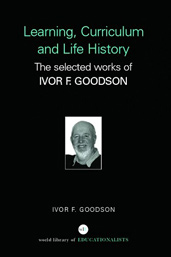Learning, Curriculum and Life Politics: the selected works of Ivor F. Goodson
Long Waves of Educational Reform
Historians and social scientists following the Annaliste School see change operating at three levels of time – long, medium and short – which interpenetrate in a complex manner. Here theorists provide an allegory of the ocean to capture the main characteristics of these three categories or levels and their interdependent mode of operation.
Looking at the ocean, at the bottom, representing long-term time, are deep currents which, although apparently quite stable, are moving all the time. Such long-term time covers major structural factors: worldviews, forms of the state, etc. The movement from pre-modern to modern, or modern to postmodern forms can be understood in terms of these broad epochal shifts (Bell 1973; Denzin 1991; Lyotard 1984; Wright Mills 1959). The effects of the emerging social, economic and political conditions of the postmodern era upon the organization and practices of schooling might be understood in these terms (e.g. Aronowitz & Giroux 1991; Hargreaves 1994).
Above this level are the swells and tides of particular cycles representing medium time. Such medium-term time has been conceived in boom-bust like spans of 50 years or so – although, with the compression of time and space in the postmodern age, these cycles may themselves undergo compression (Giddens 1991). It is within these medium-term cycles that one might explain the establishment of the current ‘grammar of schooling’, for example, as classroom-based, graded and subject-specialized schooling in the latter years of the 19th and early years of the 20th centuries. As Tyack and Tobin (1994) admonish, unless reformers begin to talk the historical ‘grammar of schooling’, their attempts to initiate educational change will be forever thwarted.
At the top of the ocean, representing the waves and froth, is short-term, everyday time: the everyday events and human actions of ordinary daily life. Proponents of this view of history often celebrate its empirical specifics against the grander theoretical claims of epochal shifts between different historical periods (e.g. McCulloch 1995). These theorizations of history should not be treated as competitive, though. Fine-grained empirical detail and broad-based theoretical sensibility are complementary forces in history and complementary resources for interpreting such history. Much of contemporary change positions itself here ‘at the top of the ocean’ in the waves and froth: the legacy is therefore unlikely to be enduring.
The most interesting points for inquiry and investigation are when the different layers of historical time coincide; for it is at such points that inclinations towards and capacity for change and reform are strongest. Such co-incidences or conjunctures can be seen in key moments of educational history and change.
